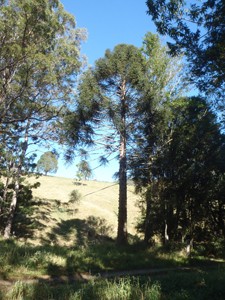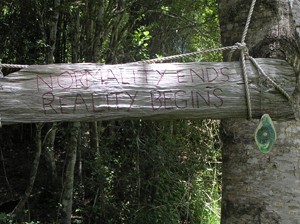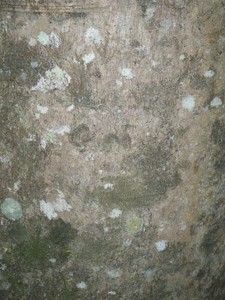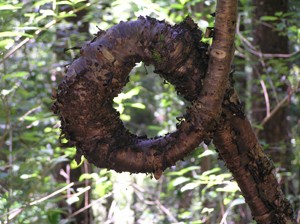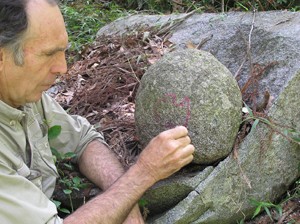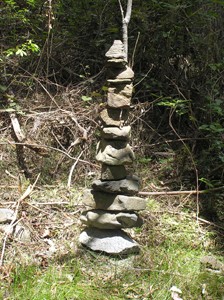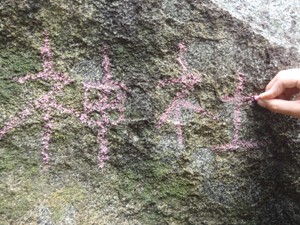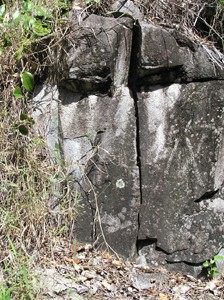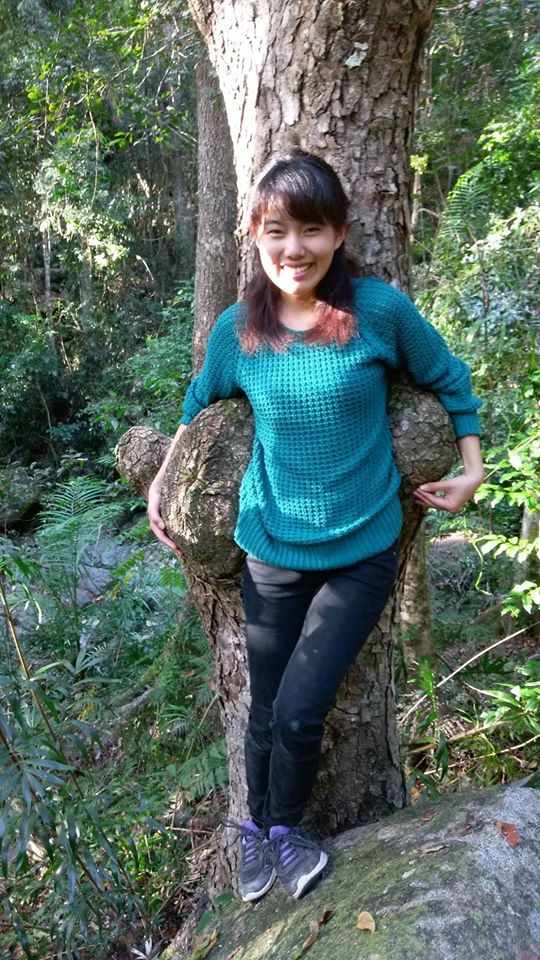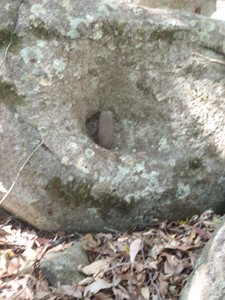Chapter 1
A Visit To My Farm
I host the occasional visitor where visitors do some work in return for keep but a visit to my farm isn’t like a visit to a more ordinary farm. The reason is that I plant and grow these trees for timber, a very long term project where the returns are in the theoretical and distant future as opposed to normal farming where the returns are more immediate. Although the physical work is important, the biggest challenge is in fact, psychological. The work of site preparation, planting, weed control, pruning and then eventual growth takes many, many, years before a possible income is generated. So far my wait is now over 30 years and all with the risk of cyclones, droughts, fires, market fluctuations, and changing government regulations. It is a strain which no normal outlook can endure. A different approach is required. Work here has to be done like a hobby or better still a meditation. The enjoyment is not to be thought of as a reward in the future but in the present moment itself. The pleasure of growing trees as something of beauty, the pleasure of repairing the environment and the work becomes yoga in nature.
I am not a workaholic. Work has to be seen in its true perspective. The rules for work here are one, only work when one hears “the call”. Two, work always as slowly as possible. While there is movement there is still hope, and three, if you wish sit and daydream and enjoy a heat induced rustic reverie, it is okay since it must be for a reason. Just one inspirational thought may by pass a life of drudgery. It is the philosophical recompense that is our goal and the chance to reflect on life and its meaning. The good news is that while we sit and think and devote ourselves to the Religion of Good Ideas, my trees are all out there growing all day, every day, year in and year out. Time may weary me but my trees are getting better day by day.
Sometime in the future, I’ll have my sawmill and hopefully all will be well but in the mean while, I’m left with my thoughts. I suppose this book is about my thoughts and experiences. Yes thinking is my religion and even recompense.
Thinking
What a great and mysterious process! Planet earth, once a barren rock, eventually delivered humans by the not understood means of evolution, and since then, we humans have then added civilisation. All of our efforts have come about by thinking and the resultant inspirational thoughts. When the torchlight of the human mind is directed to a problem, marvelous solutions have appeared. Jumbo jets fly reliably and passengers don’t even consider or even have the thought of the technical problems that have had to have been overcome for 350 tons to fly 400 passengers at 600 miles per hour from one side of the planet to another in 20 hours and in safety. The internet looks so natural but the coming together of so many areas of human thinking to direct a controlled stream of electrons by binary mathematics to me and my computer screen is incomprehensible! Individuals have spent their whole lives just working on one problem and when a solution is reached, the general public buys it, uses the consequences and takes the benefits, and forgets the mental effort which has gone into it.
Thinking is applied in technology and good thoughts can eventually be proven over the bad ones because they work. Thinking is also personal and we apply it in our ordinary lives and I argue that the process is still equally powerful. We live on the cutting edge of time. Our lives are not static and decisions must be made from one moment to the next. An issue arises, we think about it and come to a conclusion. Unfortunately not all of us look at the situation dispassionately and clearly. Too often many of us just follow the established and inert pattern of hackneyed phrases, clichés and platitudes. Perhaps we could look at scientists and musicians because these people have proven good and inspirational ideas to see how and where their ideas came about.
I suppose that I have two general ways to the reservoir of ideas. One can come anywhere, anytime, while doing anything and a so called good idea will come into my head. The other is upon waking and a good idea is just there waiting. These good ideas are exceedingly precious because one good idea can inspire and dominate us for the rest of the day, the week or the rest of our lives. Receiving ideas seems a passive thing. The subject matter or situation is know, the question is posed and we just wait for the new idea to land from where we do not know. That subconscious space is like a void behind a door left open. I never feel responsible for an idea, I didn’t put it there, it just arrived, but I am responsible for what I do with the idea. One thought can motivate us into action and its consequent results. Some time we have a problem and no thought seems to come for a solution. Day after day the problem grows and so does the tension and stress. It is commonly argued that this tension is a bad thing but I would argue that it is necessary. The tension I hope is like a pressure cooker and the resultant reluctant thought will be eventually born.
Other times we have the thoughts but due to inertia we don’t act upon them. Sometimes we are literally terrified to break the patterns of our normal and becoming redundant self. These can be taboo and dangerous thoughts we dare not even mention. This inaction leads to I believe depression. We have the thoughts but fail to act on them. If we have a certified good idea in our head, it is demanded we must act upon it. If it is a bad idea, it will eventually be forgotten, and die. A good idea demands at least the first step be taken and this will lead to its sequence of another idea or more action. If a problem occurs the solution may seem impossibly far away but all that is needed is the immediate first step and the consequences need not yet be know but will eventually follow. Maybe the lesson is just general life experience which leads to a greater knowledge of life. Evolution occurs for species and life also seems to be a learning experience as we evolve from one idea to the next. How else can we resolve the sometime difficult problem of telling the difference between a good idea and a bad idea as initially they may look the same but by the experience of life. Another general rule is that when in doubt, do nothing. Time will define more clearly the problem and the needed solution becomes clearer.
If thoughts are so powerful, maybe they can even transform our ordinary lives. A place need always left open in our mind for the arrival of thoughts. Maybe if noted closely and acted upon with propinquity, that is at the right time and place, they are serendipitous, that is that no matter what, good fortune will always follow. The sun is always shining, the traffic lights are always green, we meet the stranger and receive the message and the inexorable flow of time continues on with us welcoming each moment. Evolution continues to what we hope is the eventual redemption of this beautiful blue-green planet and we play our little part in the whole scheme of things and it all progresses smoothly. We can only hope! Oh, blessed reverie!
Taking Life Seriously
I believe that I had a difficult childhood for many reasons which even now I won’t talk about. As a consequence, there was a lot of pressure on me to perform academically which was unfortunately against my ability and nature. By great personal effort, I found myself in first-year university studying science. This was so difficult, you cannot believe it. Incredibly in our small church, I had to go to church in those days, was someone a year older who had passed this subject and he gave me some valuable assistance which I’m quite sure helped me to pass the exam. I then went on and completed the degree.
I got a job and because of my nature, I saved all my money. Frankly, I hated the work and decided I wanted to purchase a degraded farm to lead a more casual lifestyle and to put into practice my environmental morality and to restore it.
While working, I met someone who had a similar mindset. He then resigns and rents a cheap farmhouse in an attractive locality. I visited a few times and he told me of a nearby farm that was for sale that had all the characteristics of what I was looking for. After considerable effort and consternation, I was eventually able to purchase this, in some peoples’ eyes, a serious liability. Over the years, my tree-planting has transformed it into an arcadia.
After I had moved in, the old neighbour told me that the farm had only come onto the market to be sold because the previous owner’s elder son had died from a snake bite. A very symbolic and sobering death.
After moving in, and probably having been here for about a year, I noticed the initials of a previous owner carved into the wall. The thing is that these initials are the same as mine. I cannot help but think, is this seriously strange or is it fate?
Looking back now, I can see a chain of events that is even distressing. The first person who seriously helped me was killed in a car accident about a year later.The second person who told me about his place was also killed in a motoring accident a year or two later. The third person to die, I’ve mentioned as he was the previous owner’s son.
My grandparents were theosophists to a degree and I always had an interest as well. The first person who died,I believe that I met in my one and only vivid dream, a few days after his death. Not long after moving in and meeting some of the locals, I discover that there was also a local theosophical group. I then make a request to join and am accepted. It has since been disbanded but that does not matter.
In my own way, I take life very seriously. I can now see how several people somehow by fate, had helped me and seemingly from my point of view, then lost their life. I know it is too much to say but could their mission have been to assist me? It is a troubling thought. Yes, I did my treeplanting and the farm has been transformed from desperation to arcadia. A visitor once exclaimed, perhaps in a different context but still here, “I have truly found paradise!”
On joining a local theosophical or perhaps an esoteric group [this story comes later], we were told that it was like going to war. Life is to be taken more seriously.
A Secret Group.
I once belonged to an esoteric group that had all the appearances of being a secret group and probably was even misunderstood as being one but it certainly was not. In it we studied what was in effect a branch of theosophy which could also be looked upon as being the ancient wisdom or even the occult. The in effect study group was organised by an older lady who had a forceful and even charismatic personality. To be in the group, one had to make a commitment to at least study conscientiously for the the two and a half hours of the weekly meeting. If this couldn’t be done, well you were expected to leave and members did come and go to an extent. There was absolutely no stigma in leaving because it was just thought of as being not suitable now in ones life and this could have been for quite a variety of acceptable reasons and durations. There was no such thing as being evangelical. You were either interested in such things and might ask to join, if not it didn’t matter.
The lady’s name who organised the group was Louise and she purchased a small farm and house in 1973 when she was 59 years old [she drew a parallel with her being born in the same month WW1 started]. She was accompanied by another lady, Esme who was a little younger and who was really her assistant or probably even her disciple. The land they purchased was in a commanding position at the end of a steep driveway on top of a round hill which had views all the way down to Noosa and the ocean. It was obviously in a striking location of significance in the landscape and although it was never said, it would have been considered as being what I will call, a minor sacred site and this would have been consistent with the philosophy that was studied. I once asked Louise what she thought of her place when she saw it for the first time with the option to buy it. She said that to purchase it was the most sure of thing she had ever experienced in her life. A rather strong statement I thought because what she was implying was that she had been guided to there by what is above. They purchased it from a father and son Buddhist pair who owned it only briefly and who must have bought it for a similar reason. The son even saw my place when it was on the market at the same time and had even considered to buy it even before I had seen it. I also consider my farm to be in a significant location although of a quite different aspect. When Louise and Esme bought it, they spent some money fixing up the house and property including putting up a new green letter box down on the main road. On the letterbox, they painted the new name for their place, “RIHUREL”. This is code for Right Human Relationships. To do this was really an act of audacious affirmation for their commitments to the worlds beyond and there obligations and commitment to being here. Louise was really quite academic and could speak fluently several languages. She purchased the place primarily for her study and meditation together with her like minded assistant but they also saw that their duty was to conduct a study group and to be an example of their nailed to the mast commitment of “right human relations” , a quote from the studied books and its underlying philosophy. Here again it could have been thought that she wanted it so that it could become some sort of ashram with her as the guru with her devoted students but this was never intended at all. All she wanted was for it to be was a special place for her and Esme to live and study plus a meeting place for her little group. She thought that there being here was also a service to the community. They also planted and cared for quite a few trees as well to improve the aspect. Her favorite tree was not surprisingly, a sacred Deodar Pine from the Himalayas.
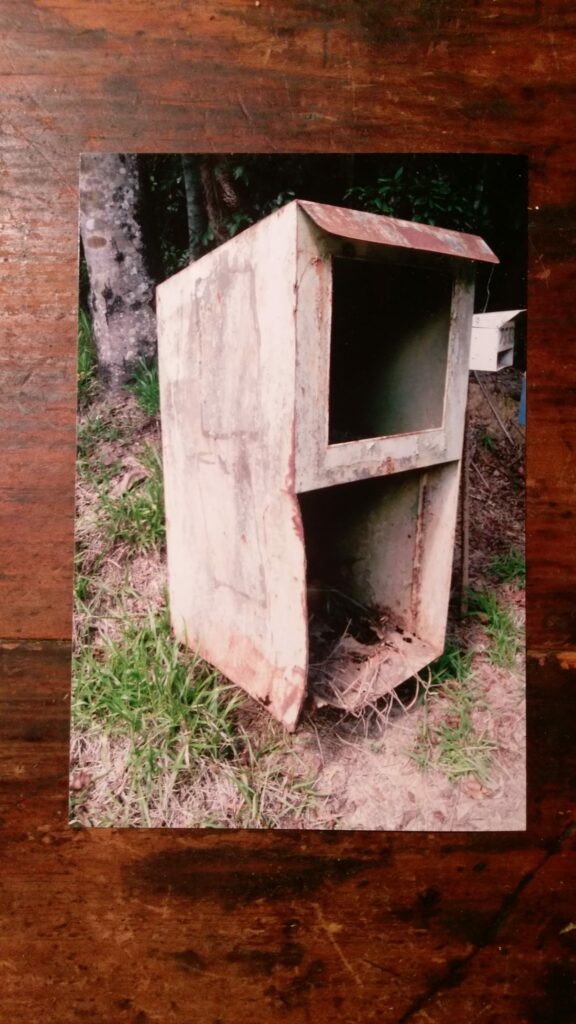
Not long after they had moved in, a friend of mine, Chris, who also had a philosophical interest in the other worlds and was living in the country for its aesthetic back to nature charm, decided that he and his girlfriend would go and visit just out of the blue and from sheer curiosity, these two new and maybe unusual additions to the mostly conservative farming neighborhood. They set out in the Morris Minor, only just making it up the steep and even forbidding driveway for this unannounced meeting. It must have been a quite remarkable meeting because each must have been most surprised at meeting someone else of significance in such an unannounced way and in such a rural backwater. They would have both talked of their reasons for being here and what they were doing and I believed that Chris would have immediately requested joining the group upon learning of its existence and that Louse would have acknowledged him and accepted him immediately. It was this group that I also joined several years later. Louise had a forceful personality and generally we were kept on track with our study but sometimes personal issues would creep in and cause disruptions. Maybe her style had been affected by Ron Hubbard of Scientology fame for she had previously studied with him before she said that he had gotten off the rails. It was quite an exciting thought that some how occult study and taking life seriously can affect ones fate. That is to be aware of ones thoughts and watching the flow of events with the passing of time. We were told that to join the group was like going to war, life was to be lived at a higher level. Life would not become more easy but more challenging and more difficult. Our weekly meetings were entered upon with a degree of trepidation. We were all out of our depth as would be expected but at least we were there making some sort of effort. There was also another rule and that was if you had a negative thought about any member of the group, you were expected to let them know about it. This is I believe, more of an influence from Scientology and is certainly good in practice at least theoretically as we were all expected to be conscientious in our approach to life and to be open to helpful and ideally caring suggestions and to be able to handle them with an objective mental detachment. I believe though that this was usually not acted upon in the name of letting contentious issues lie, but to be sure, this did on occasions set the cat amongst the pigeons. Louise though was never daunted by the emotional fireworks that could result and always gave the impression of being above such petty and even spiteful issues as we were sure humans with our weaknesses.
Time passed and a few members came and went while we continued to study books with such evocative names as “A Treatise on White Magic”, “Cosmic Fire”, and “Initiations Human and Solar”. These are to be sure heady topics and how much we understood would be open to question, but the point isn’t so much what you understand as it wasn’t written to be understood like a manual but to open ones mind to the greater world beyond and maybe the best way to comprehend it is by it being made clear that we do not understand but to be open to greater things. Life is always the real school and we all had our precious and different points of view on life and how we understood it all in varying degrees. We were then expected to put the results of our study into some sort of practice. One of the members even temporarily withdrew and spent some time in Poona, India with Bagwan Rageesh and his libertine and even notorious views on the mysteries of life. Although this certainly wasn’t approved of, it didn’t really matter all that much and he later rejoined the group. My personal view and commitment to life was much more grounded and ordinary and centred upon my family, house and farm.
In the wider circle of those who study such things, she was relatively quite well known and friends and associates would occasionally recommend someone to visit which included the occasional passing pilgrim of life. Occasionally a couple of Buddhists dressed in their robes would come from Chenrezig for a sort of holiday I suppose it must have been for them. The monks offered to do some work for them and were given two lawn mowers to cut the grass. The lawn mowers had their names painted onto them. One was Agni, [agni as from agni {fire}yoga] and Salamanda, [a mythical creature that lives in the flames]. They set to mow, not in a methodical way as we would but by starting somewhere and by running randomly and excitedly all over the place. It must have been the first time that they had ever used a mower and was quite a sight I’m told in their orange robes. She was always a bright and intelligent conversationalist and I’m sure many people remember these friendly and insightful times.
In the meantime though, Louise’s health continued to deteriorate until it all became too much of a burden for her. I believe that she also became some what disenchanted with everything and I suspect thinking that she had put so much effort and commitment into it all and what was there to show for it all? In the end, they decided to sell out and sold in late 1984, finally leaving early 1985 and a most fascinating chapter came to an end.
Late in 1985 as it was getting dark and I was driving past the green letter box, with the now “RIHUREL” painted out. This had been painted over by them when they left. I had in the utility with me, the caretaker of my farm, John. It was exactly here where we were flagged down by a young lady in her 20’s. We stopped and she told us that her car wouldn’t start because of a flat battery. Naturally we were willing to help. We tried to start the car but couldn’t jump start it because the battery was too flat. She went on to tell us that her mother was stuck in the house at the top of the hill and wanted to leave because her German husband had gone mad. My immediate thought here was as to what sort of ghost from the past was this? The young lady was here to drive up the hill to facilitate her mother’s escape. I suggested that we walk up the hill as I had already done so many times and to do so it the dark without a torch would be no real trouble. She said that the husband had disconnected the telephone to prevent contact and had cut down a few trees across the road to make access all the more difficult. I said that a walk in the dark would not worry me. The three of us set off up the steep forbidding and now dark hill, through the crown of the several trees and on into the dark. When we got to the top of the hill, John and I stayed close by and watched while she went to the front door and knocked. He opened it, neither of them said anything to each other, she looked in, saw her mother sitting inside, [at the very location where we had our meetings!] who immediately got up, stuck a few things into a plastic bag including incredibly of all things, a vacuum cleaner, and just walked out. Nothing at all was said by anyone until the two of them got to us. It was obvious what was next, we were all to leave together in the dark. We then staggered down the hill together thinking how clever we were to have made a successful escape. When we eventually reached the bottom of the hill, it was agreed that I tie her car to mine with a tow rope and towed her back to Pomona where we left the car and John at a garage and I took the two of them back home to Noosa. Is that strange and what should I think of it? What was the karmic lesson here? I was told that the mother actually died suddenly a few months later. She must have only been in her mid fifties.
Louise has now been gone for many years and what is the legacy of all of this? She came from a Swiss family that was a little bit wealthy and said that money was never a problem in her life and always allowed her to do what ever she needed. She had formally studied art as well as languages. When they knew they were leaving, she gave me an interesting piece of art that she said was quite valuable and this has looked over me almost every day since then. I sometimes look at it and wonder of its meaning and its power as an object of art as art also possesses an influence upon the human psychic.
The allure of occult groups is the believe or hope that an understanding of the subject can lead to the understanding of the human condition and the mastering of our lives and that the gradual evolutionary process can be speeded up. As ordinary frail humans, I believe that first of all, we need to get our lives into some sort of order and then this should then lead on to at least interesting lives. I’m also sure that many of us, if we allowed our fantasies free rein would love to lead what I think is called, fabulous lives. It is thought impossible to aim to move on to the next kingdom with out having experienced all that this kingdom has to offer. Is it impossible to renounce what was never achieved? Well that is one line of reasoning. Another line is that to seek temporal gains is all an illusion anyway and spirit always transcends matter so you can have it either way. The key is to be aware. Another rule would be that if you want something, well you need to give something but unfortunately, the rates of exchange are unknown, well at least to us. A similar rule was the of course nebulous to only take what belongs to you. One of the many contentious issues was the importance of small things. I would argue that small things are also important as if the rules of life could be suspended, but I’ve had argued vociferously against me that small things are unimportant and so liberties and exceptions to the rule are allowed. Well of course, I think that this is glib but then in this subject, everyone is convinced that they are right because they “know” and speculations went far and wide and the state of sleepwalking was and still is confused with being awake.
Just a few days ago, I was walking on my walking track with a visitor and the importance of small things was made clear to me. I could also describe it as being the scary moment of a tipping point. We decided to go up to the cave and each collect a block of Red Cedar from a small dead tree that I cut a few days earlier. He grabbed one quite heavy piece and I picked up the other. He was just about to throw his down the slope when I stopped him and said, “No not that way but over there!” He then hurled his and I did likewise with mine. We then clambered down the track to collect them and were just about to pick them up again when there was this awful crashing of a bang, bang, bang beside us. I was shocked for the moment as I didn’t know what it was. I then realized that it was the rolling and tumbling of several rocks beside us that had some how in that moment become dislodged and were crashing down the ravine beside us. What if Ludo, my visitor just in that moment had spontaneously thrown his block without thinking as he was about to do and without me observing and stopping him. I would certainly then have then said to him, “Well you can now go and collect it!” He may well have been crushed by a dislodging rocks. A most sobering thought. At the time he was reading a book on tipping points and how small things matter, as if I didn’t know this already! Yes, loose rocks are dangerous! He left here to do a 10 day course on Vipassana Meditation. I wonder if this incident crossed his mind in those long hours and days of silent meditation and reflection.
My position on things is thinking and contemplation with its resulting hopefully good inspirations. I call it, the religion of good ideas! Louise and Esme, with their in effect, ashram, were committing their lives to these higher aims. I though am not academic and couldn’t spend much of my life with study and meditation but have for sure had an inspiration to plant trees. This also gives me the time to think about life and its next step as I wait and watch my trees grow. Being in such a group, it was very easy to be filled with enthusiasm and an overly optimistic self appraisement of ones standing. Upon discovering such things, these what I would think of as being neophytes would immediately see themselves as being some sort of initiate. I’m sure an initiate would never have the need to study things in this way. Ones standing would never be discussed as it would have been considered pure folly and utterly irrelevant as one’s task was always at hand. We were though encouraged to go with our ideas and to step up to life’s presented opportunities. It was all too easy together with an inflated ego to think of one’s self as being some sort of divinely sanctioned guru and one of the members became inspired almost straight away in this problematic way. She resigned from the group and attempted to take over Louise’s mantel when she left. She also attempted to expand herself into the greater public arena but it has not been successful and she really only confines herself and her self appointed status to her rather large and acquiescing extended family. Louise though never in any way saw herself as anything but the somewhat reluctant head of nothing more than a study group. It would have been considered nothing more than pure egotism to think of one’s self as anything more. Maybe she was more, but these were only allowed to be private thoughts. Another two, meet in the group, become a couple, and announce that their union is on a higher level and form an actual community of at least superficially committed people. This fails in the end and everyone moves on elsewhere. Another former member now sees herself as a self-denying saint who has even built a large center/ashram to have her saintly status acknowledged which though is still tragically empty. Others in the group I’m sure now give it little if any thought and are as, as so-called normal can be and I’m sure that others know if they give it any thought at all would renounce it all as hocus pocus. Another member though became a sort of successful and a little bit famous as a talkback radio show host, interviews a then current Prime Mister and they even appear as mates but I know for sure that when the host was in his what I will call, his Rasputin days, he would have had no time at all for conventional politics and worst of all, conventional economics and for example the crazy and destructive concept of economic growth but now he seems to endorse it all. Could this have been a betray of principles? A year or so later he dies suddenly and youngish. A severely worrying thought. What was the gain there? Just yesterday I heard on the local news the name of another former member as if to remind me, it is presumed that she was murdered several years ago and her body has never been found. Another has a partner who is involved in a terrible accident. If we were still in the group together, the obvious question could not but have been mentioned that if the former member in some way if she had somehow know more than she could have somehow averted this terrible accident? For a normal outlook, this question might be considered irrelevant or even neurotically paranoid but within the group, it may have been considered. What does life at a higher level mean? The results would be if one could look at it in a conventional way, it would have to be mixed. I though confined myself to austerity and treeplanting and the ample rigors that life supplied to me. I liked another quote from the books that “the vegetable kingdom is the major achievement of the planet”. This I can believe as the human kingdom is surely full of faults. Another friend who was never in the group, but who is a philosophical recluse says that he doesn’t have much to show for all his efforts either. I do though think that it is life’s natural progression that if one reaches a certain age, one has a desire to pass on what has been learned. We are all on different paths and have no choice but to be true to our own path. I have another friend whose way is meditation and he would like to set up a school for meditation. What now of myself? Well, I continue to plant trees and they continue to grow. Eventually, I purchased a small mobile sawmill to start to cut some of the trees and make some much needed money. It is quite a cycle to plant the tree, grow it, and then cut a few of them down and saw them up and sell the timber. I also decide to write out some of my stories.
Now in 2013, as I drive past the now unused green letter box in its state of almost total ruin, I can’t help but still wonder of the brave “RIHUREL” that was once painted there and what it once meant. I do though remember and would like to make a confession. At the time, my farm was in ruins, the house was a wreck, and the land was devastated but my perspective on life was to fix up the house and to replant the land with trees and to transform it into an arcadian paradise. Now years later, what once looked like a desperate liability has now been transformed into a vastly different place. I think though that cynicism plays too much of a role in our lives. It is obvious that thoughts and actions can transform our lives and occult studies imply that this can change can go even further and change our karma, fate and evolutionary position. To say this I even now feel is heresy against the mainstream cynicism. I though think of my place as being more than in just a striking or significant location but actually even what I call, a minor sacred sight. Over the years I have learnt of its history and the poignant set of circumstances that led to it coming on to the market for me to purchase. Another group member also purchased his land as a direct result of an even more powerful set of tragic and disturbing natural circumstances. Mine was death from snake bite while the other was death from a rare local tornado. Of me then learning of these facts, to then to have been given the insight as to it being as to what I was looking for and being as to what would be possible from a desperate situation, the farm physically and me personally. To then to have been able to seize the moment through much difficulty and was it luck as well; of course, we would never say luck as there is always a deeper reason, and then to be able to purchase it only with my own hard earned money. To have held on to the vision through much strife and rancour. To have planted the trees without any encouragement from anyone other than surprised disbelief and then after the work, to have to show no immediate improvement to the desperate landscape. To have fixed up the house and to have made the changes that have turned it into a most wonderful and comfortable houses to live in. To have seen its position in the landscape and to have made the connections. To then discover weird alignments between me, the house and the landscape. To have made a walking track that circles the farm which I and others have then used as a walking meditation. To have then made a jungle shrine where visitors have made confessions. To discover a tiny stream whose source that is here on the farm that never even in the worst droughts, ever stops flowing is more than just remarkable and also to have discovered a largish cave. To have spent my life here where just to look at the now green hills is more than a comfort to me but a positive affirmation of life and nature being able to repair its self. To have visitors tell me that what they have had experiences here that they will never forget. For them to say, because of all the good health of the planted trees, that the air is so pure and invigorating and for them to go on and say that the green colour that on occasions can be best described as being an electric green, and is just so healing upon their tired city eyes. I look back and I am just so grateful of a life that early on, was so much on the edge. To have made something out of so little, I find miraculous. I don’t claim to know how or to who or what, but I can at least write the word gratitude and dwell upon this as well.
I said to my neighbour, that I had lead a very lucky life. She said that I had lead a very, very lucky life. Oh how true!
I still occasionally pass by that now ruined letter box and the still painted “RIHUREL” although now unseen but surely still there under the repainted green coat of now faded paint. I still do remember something from all those years ago and I am still extremely grateful for all those lessons, visions and the opening of a door to a life far beyond what I could have thought possible and the audacious thought that inspired those two older ladies to come here to study life and its deeper meaning.
While I sit and think and watch my trees growing, I take the time to write out the manuscript of my treeplanting life and of all the transformations that have occurred. It is probably more a catalogue of weirdness. I have decided to call it, “by the grace of the Pine Tree”. A quote from one of my more abstract visitors, a lady who worked at a Zen monastery and a indication as to the source of it all.
The Hidden Agenda
[that fated me into becoming a treeplanter]
What are the events in my life that have somehow set the scene for me to become a tree planter? After I had been living here for quite a few years, and had started on my tree planting way of life, I started to think why am I doing this? As a child, I lived in an old timber town which was famous for its hoop pine forests and the timber which they produced. By the 1950’s when I came to live there, the hoop pine industry had completely gone. The rainforests of hoop pine were logged out and gone. The town was only half the size it had been and there were still several derelict houses around and the bare ruins of others. Just in front of the house was the remains of an old bullock wagon and just down the road and a turn right away from the town towards where other houses of the town used to be was a still complete bullock wagon. In the school grounds was the remains of one of the steam engines which brought logs from the forests to the town sawmill. The timber business was gone and so had much of the town.

when I was a boy that my
mother looked after for many
years before I planted it here
in 1976.
Not long after we arrived, some of the hoop pine that still remained around the house had a large crop of seeds and I can remember with some of the other local children collecting these seeds and planting them or else collecting these seedlings as they germinated and helping them to cast off their husk and planting them. In a letter I wrote to my aunt at that time I said that I had about 90 of them in pots. Now hoop pine is a remarkable tree and it able to be suppressed and to still grow very slowly for many years in this most restricted environment. In fact 17 years ago, I had the “good” idea of growing some hoop pine in some bottles. I chose a bottle because I could keep them in doors and no water would leak out as it would from a conventional pot. Anyway all 3 hoop and one bunya are still alive and well and they have hardly grown at all. Just give them a little of what they need for life and they will hang in there. Three of these hoop pine from Canungra were kept alive in these pots for about 20 years by my mother until she eventually gave them to me to release here. One was even actively kept by my mother as a bonsai in a tiny pot, about 3insx2insx1ins and was still only about 1foot tall. All three are growing at my front gate and one is even quite large and all are healthy. As a child I also used to think where I could plant them out. I even thought of having a farm and planting them there but I didn’t know how that set of circumstances could come about.
I used to sleep on the verandah in those days and I used to look out onto the slopes of that unusually named mountain called Mt. Misery which rose beside the town. On its slopes going down to the town and the site of the sawmill, had been planted several rows of hoop pine that went half way up the hill side. I had been told that they had been planted many years earlier by the sawmill owner, a Romeo Lahey. An obvious gesture to all the destruction of the hoop pine that he had participated in, in his short term exploitation of the resource. The story is in actual fact a bit more complicated because Romeo Lahey was one of the leading conservationists of this time and it was his efforts that lead to the declaration of Lamington National Park, Queensland’s first great national part and the forming of the National Park Association. Even as a child I was vaguely aware of this paradox. The departed timber industry and the social disruption indicated by the abandoned part of town, the gesture of the tree planting to some how indicate the direction that should have been taken, and also the advantages of a large National Park from which flowed Canungra Creek which was reputedly never known to run dry, and where I spent much of my spare time.
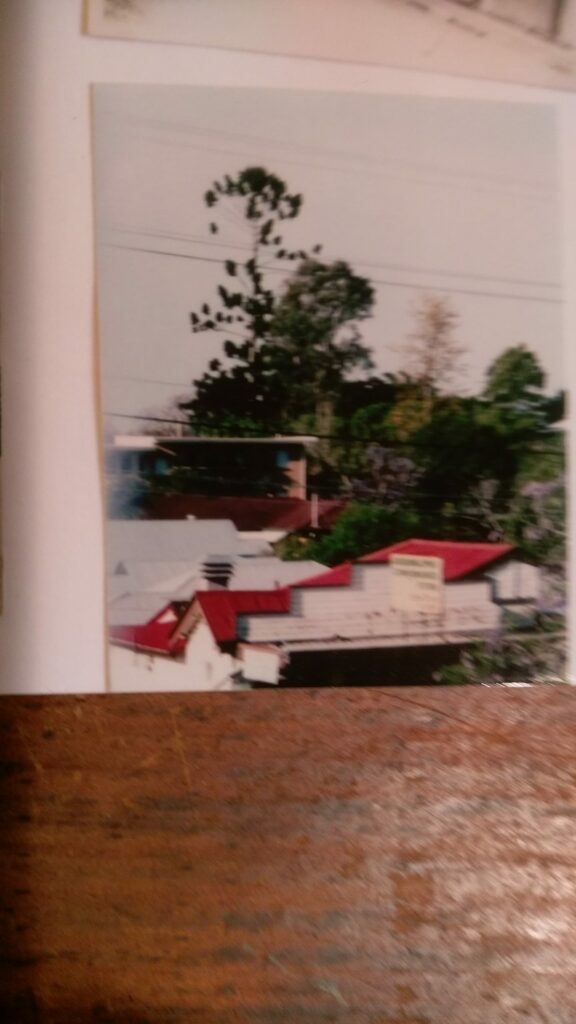
back yard of his house in Bunya Street
now overlooking the suburb
Years later, I now have a degree in forestry and am working for the Queensland forestry department growing hoop pine in plantations. The problem I have is that they in the 1970s are still clearing valuable rainforests and good eucalyptus forests to plant their hoop pine while there are vast areas of already cleared private land that once had a good forest and has now degraded and growing mostly weeds. I also hate going to work every day and because of my rather austere nature have saved up enough money to buy a completely clapped out farm myself. What do I plan, well of course, I intend to be a tree farmer and grow hoop pine on these eroded and weed infested slopes. I’ve grown trees in the forestry and now I intend to do it for myself. Eventually it will make some money and it will be a vast improvement on what is there already. One thing happens after another. Each step seems sensible in itself but little do I realize at the time that somehow it is fate or my subconscious that is setting me up to play out the consequences of my thoughts that were set up for me early in life.
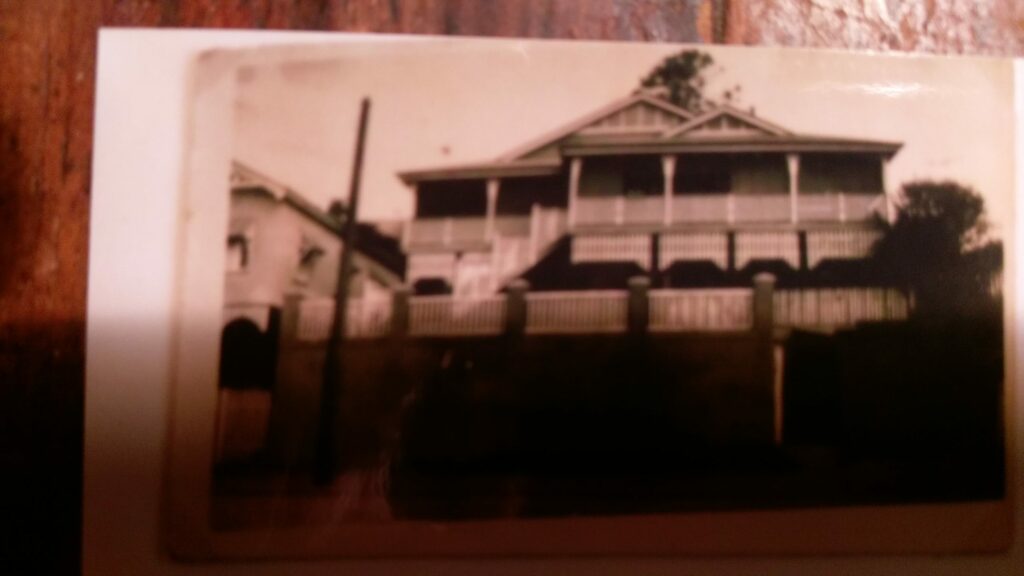
How did I end up here? Well I have also found another peculiar thread. I surmise that when my parents first meet, one said to the other, “Where do you live?”. The reply was, “Bunya Street”, (which was true, and in the bucolic sounding suburb of Greenslopes), and the other said, “That is strange since there is a largish bunya pine in my back yard!” (which was also true). I could be cruel and say that is all they had in common other than being good Christians but they did eventually get married, my grandfather in the meantime did plant in the back yard of his house in Bunya Street, not a bunya but a hoop pine, but I can see what he was getting at. That tree now many years later dominates a part of the landscape of the Greenslopes suburb while the bunya pine at the other house was eventually cut down because it was too prickly, and dangerous with its large nuts that sometimes fell from it. I did though help my grandfather cut down a runt hoop pine in the back yard beside the garage and it was used it as a Christmas tree one year. I was eventually conceived just west of the Bunya Mountains and so when I visited the farm here for an inspection before buying and I saw a bunya pine at the front gate, planted by the previous owner in a fit of prevision along with several other bunya pine, naturally I feel that I have come home. My sister now lives in my grandparents’ house in Bunya Street and I turned into a tree planter, growing mostly hoop pine but also the occasional bunya. No wonder I like to keep one growing on the back verandah in a pot. Is that called a talisman?
On the subject of growing trees
Growing trees is very exciting as they get bigger and bigger and transform the environment back to green health but it is a slow gratification. Sometimes though I need to cut one of these older trees down and recently I cut down one that was 124 feet tall. Growing trees may be exciting but it is quite a thrill in another way to cut it down. Don’t worry, I sold it for money and other better trees have taken its place.
An overview of my Farm
From the Walking Track
If a visitor arrives, I usually take them for a walk on my walking track circuit. I even host the occasional group and recently took an artistic group for this walk. This is how I described my walk to them. The source of the inspiration for art is the real allure and can it be found in the wild beauty of the jungle? The track is about 3 km long and can be walked briskly in about an hour. I sometimes walk it as a walking meditation.
The Jungle Path as a Venue for Art
Visitors enter through a large old silver gate and then up to the old style Queensland house The path starts here and leads from the comforts of the house and into the dark and mysterious realm of the jungle. The path is the ribbon of smooth over rough places, leading us in comparative safety and security into the unknown and uncivilised jungle. From the path we view into and over the wilds and feel that the unknown has been tamed. Art is the achievement of civilisation but uncivilised nature draws us with the allure of its beauty. My path explores the tension between these two opposites.
The House
I’m very keen on the metaphor and coincidences and although I won’t go into them here, I’d like to point out the similarity between the shape of the roof of the house and the mountain behind. From the deck at the back of the house, the sun on the summer solstices rises at 6am exactly behind the peak. This and a few other things I take as the house and landscape as being sort of my own personal stonehenge. I’m always looking for evidence as to how the void or the subconscious influences us either as for example fate or artistic inspiration. I look to Nature and here it is the mysterious jungle and landscape that is our source. As far as I’m concerned, I live in a paradise but I’m sure that the previous owners would have thought that they lived in hell.
The Dairy
This Dairy has been converted to something like a grannie flat. It has mains electricity, kitchen, bedroom, wood stove, sink, and septic toilet. It is in fact, very comfortable and quite a few people have lived here over the years for sometimes years at a time.
Gully Water Hole
gully water holeThe first seat is at a water hole in the gully. This water hole is miraculously always full as it is fed by a little gully that I’ve never known in over 30 years to stop flowing. A carved sign says, “Normality Ends; Reality Begins”? Just over the other side of the gully is a tree with the initials of CM carved into it or is it a GM which for me stands for the second most popular tree for me to plant, the local Gympie Messmate. Who did this and for what reason is now totally lost.
The Ozzie Sauna
That’s what I call it but it’s not a sauna but an outdoor bath with a 44 gallon drum, filled with water and heated by a fire. With the help of an assist to set the fire and bucket the water, the person taking the bath gets as red as a lobster before jumping into the water hole to cool down before returning to the bath again. This can be done all year round because our winters are very mild.
Pine Plantation
A little further on, we enter one of my ordered forests with the trees so tall and straight and all planted in rows, well sort of anyway. One of the trees here has done the impossible and instead of growing upwards like all the rest of them, has by a freak of nature grown into a circle before heading upwards again. The impossible has become possible. The natural laws of nature have been turned upside down and there is a sense of the unease.
Placed Rocks
We now glance at a strategically placed rock and the question is posed, is it natural or has it been placed there by the hand of man and if so, for what reason? Is the motivation art or is it just a whim? Man has been placing rocks for thousands of years and I’m drawn to the pastime as well but I don’t know why. The next rock looks like a horses’ skull.
An interesting small rock catches my eye and I pick it up and carry it with me to place in a suitable location.
A Spherical Rock
The next rock is a sphere resting on another rock. Under the plinth I have stored a piece of chalk, and using this makeshift globe, I might draw the outline of Australia.
If my visitor is from overseas, I might then invite them to draw their own country.
The Hut
A small clearing is entered and here there is a small and remote hut. Inside are a wood stove, a single bed, and a desk. This is occasionally used by visitors looking for solitude and a back to nature experience.
On the back door is a little mural painted by two hippy girls. One a business graduate from the US with a professional background and whose father was employed on some secret mission in the Pentagon and the other a natural free spirited hippy from NZ. Together they were travelling the great magical land of Oz doing spontaneous abstract murals as acts of goodwill. After sampling the casual life of a hippy, I never discovered how successfully the US girl returned to the grim reality of her business world.

The hut 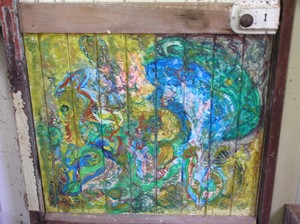
Their collaborated work of art 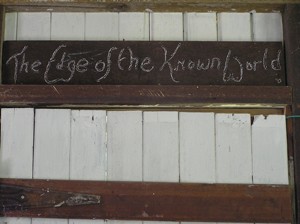
The warning amphorism in the hut, “the edge of the known world”
Above the door is a sign carved by another visitor saying, “The Edge of the Known World”. The path is taking us beyond the known and into the mysterious unknown.
Cairn
Next a fork in the path marked by a cairn, the ancient sign of human habitation. This should still be standing unless the cows have knocked it down since they hate all aspects of my landscape art. The left hand path goes down into the rocky gully, and past a probably a dry waterfall. This path which we probably won’t use goes directly up the hill, over a balancing rock, through a tunnel large enough to walk through, past a bat cave, lookout and onto the camping cave.
Ozzie Gothic
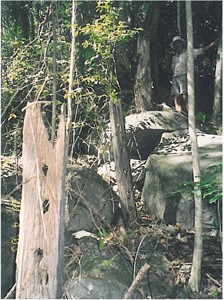
Go straight ahead and if you look carefully at your feet, there is a piece of bent and rusted barbed wire. Further to the right, is even the well preserved remains of an old fence. This fence is symbolic of the changes that have occurred. One hundred years ago this was untouched rainforest. It was cleared and burnt and turned into bananas and pasture for cattle and a fence was build with confidence for the future. Now this phase seems almost impossible to perceive as the jungle advances slowly and relentlessly and civilisation is in retreat. This is an example of what I call Australian gothic. A now a mysterious ruin of a lost or declining civilisation and a pioneer way of life now almost totally lost.
Sally’s Horse
Just before the next intersection, look up and there is in abstract form a galloping horse in wire and fibreglass.
Jungle Caves
To the left, the track goes across the gully, up the slope and to the caves. One cave is deep and quite a claustrophobic experience to enter. The other is big enough to camp in and occasionally visitors have spent the night here. Someone even came all the way from the U.S. to camp in this cave and experience the closeness of nature but living here is very rugged. This cave has been visited by a child as young as 6 weeks and a man as old as 87 years so the path can’t be too severe.
On the way here, the track goes past a giant ancient rainforest tree. This tree’s botanical name was named after the government botanist who as a boy lived over the other side of the range. He wrote a famous rainforest book in 1926 with photos of large rainforest trees with men strangely juxapositioned beside them holding their axes. To look at an axe, it is paradoxically mostly wood except for a one side sharpened 4 ½ pound piece of steel attached to one end. These men when the botanist left the scene, proceeded to cut the trees and whole forest down and then to burn the whole area when it dried out totally killing all plants and completely blackening the area making it look like a blackened moonscape. In fact this was one of my jobs while working in the Government Department of Forestry and I have to confess that I have even been employed as axeman and have even participated in this type of procedure. The smoke from these huge fires could be seen for many miles around.
The Jungle Shrine
A little further on along the main track is another seat and my jungle shrine. Here there is a collection of quirky and poignant things, an old cow bone, a broken piece of pottery, bent pieces of wood, reject glass beads and even a piece of gold foil. I like very much the Japanese word of wabi sabi. This word is the basis of Japanese aesthetics. It means the profound in the ordinary, the aesthetics of imperfection and the subtle beauty of nature. Here visitors are invited to mount the dais, sound the gong, a fortuitously found hub cap, and to extemporise on their jungle thoughts. For example, to quote a visitor, “I used to walk up to your big silver front gate and think that whatever lay beyond it was a mystery, now that I’ve had a look, I now know that the mystery is even greater!” Yes I like the thought. This now isn’t so much jungle art but jungle theatre or if it’s a confession, it becomes jungle therapy. I’ll come back to this later.
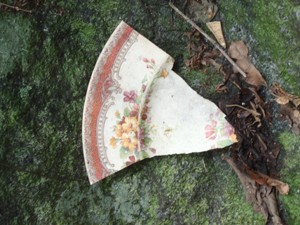
Visitors are invited to collect a piece of broken pottery and to take it with them and to add it to the walking track where ever it seems appropriate. When we walk the path, we wear it down fractionally and it is beneficial to make a little reparation. These discarded pieces of pottery which were once useful, broken into uselessness and now have become useful again. To walk the path and to be momentarily caught by surprise by a glint of broken pottery may allow us in the instant to see things differently.
The Three Sacred Words at my Jungle Shrine
The first question one might ask is if they are secret words, why do I reveal them here? Well the chance of someone reading this and coming to my Jungle Shrine is not high and if it did happen, well it wouldn’t matter.
At my Jungle Shrine which is really just a seat, a raised piece of ground, a cow bone found here on site, bent pieces of wood, valueless jewellery, and a few other incongruous things. All of this is about 20 minutes along my jungle path where there is a seat and one might sit and contemplate the difference between jungle rules and civilisation.
I have the idea to carve into three pieces of wood these three words. I would then cover them up and the ritual would be to tell of their concealed existence and if one dared to reveal them, sound the word, and tell of their meaning. A word is like an idea made manageable or a concept with a handle on it and these obscure words capture perhaps something unusual but relevant to here.
The words are Kora, a Buddhist word meaning to circumambulate as an act of reverence to something within the circuit such as a shrine, teacher or ashram,
Tirthas, a Hindi word meaning a sacred place where it is easy to cross over from one realm to another, and Apotropaic, an Ancient Roman word associated with the God Silvanus, the god of the forests. A god I have an affinity with since I have planted much of the forest there. It is the name of his shrine where apparently so I have read, one proclaims.
The Words Soul and Sole
In the biological world, there is convergence of species which means that two animals or plants have evolved from different sources to something similar such as the Australian echidna and the hedgehog; and the Tasmanian tiger and the wolf. To me it appears that these two words, soul and sole have converged from different sources to come to both mean in effect, a portal. An opening on to something else and beyond. The soul,the highest part of our body, the part that goes to heaven and is an opening to sunlight and inspiration and sole, the lowest part of our body, that which lets us absorb the Earth’s sustaining energy and keeps us grounded and intouch. One is a contact above, the other is a contact below and we are the middle principle. Of course and as a consequence I would say being barefoot [where possible] is of great benefit to those who love and wish to care for Our Sacred Planet. We can feel the earth through the soles of our feet. Modern people who mostly wear shoes on concrete are unfeelingly and happlying destroying the planet for more money to purchase even more things.
I have always wondered about these two words in English part that goes to heaven. Both the highest part of our body, the soul, , and the lowest part of our body, the very bottom of our feet have exactly the same word. How could this be? ls it some sort of joke? Well my thought today is that they have the same word because they are both portals. The soul is the contact or doorway to the above, absorbing sunlight and inspiration while the sole, lets us absorb the Earth’s sustaining energy and keeps us grounded and intouch. Yes, being barefoot [where possible] is of great benefit to those who love and wish to care for Our Sacred Planet.
The Goddess
Further into the jungle and another seat. Here there is the Goddess Pomona, found broken and abandoned at the local tip but here glued back together and hopefully with her powers restored. A drink is offered with a natural rock chalice from the clear water from an almost permanent spring. More broken pottery, this time from a local artist. Another cairn is slowly rising as suitable rocks are found and added.
The Lookout
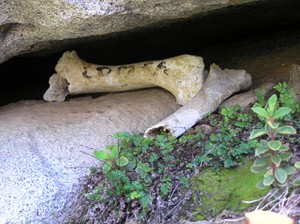
The path now turns to the right and gradually climbs the hill side. A lookout rock is reached with a view over the valley below. In a crevice in the cliff behind the lookout is another cow bone. This bone has the word “GOMPA” painted on to it. This bone was found when I planted the Gympie messmate tree beside the lookout. Bear a moment’s thought to the days when one hundred cows lived here and they needed to graze so high up on this rugged hill side for grass. Circumstances change. The word gompa is a shrine dedicated to the Buddha. This was painted by a Japanese lady who visited here a couple of years ago called Meiko and I have an essay about her a bit further on. She worked as what she called as a yoga coordinator in a zen monestary and had also studied in India. She was of a very abstract nature.
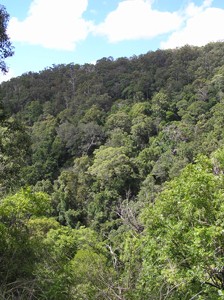
For her, beauty was found at every turn of the path and every twist of a leaf. When she walked the path, at suitable places as reverence to the beauty of nature, she painted a Japanese character in watercolour paints on leaves, rocks and stems. Upon seeing the cow bone, she prostrated herself in deference to the lost life. On it she painted the word, gompa. I suppose as an attempt to somewhat redeem the situation. Never has my walking track been so greatly revered!
The view overlooks the valley we have just walked up and across to the trees and caves on the other side.
A Deciduous Fig
A little further on are some fig trees growing over rocks. These are the same species that are growing over the Buddhist temples at Angkor Wat. A closely related species to this tree, was under which the Buddha received his enlightenment. The high roots and low branches symbolically pull together the distant worlds of earth and heaven.
A Cliff Face with a Face in the Cliff
Just beyond is a human face in the cliff. The face looks rather severe as it looks down on my farm below. On each cheek was painted a Japanese character. One is now almost invisible due to the ravages of time and the meaning is now lost, the other is a word that may be translated as respect.
A Rocky Grotto
Another cliff and some over hanging rocks with a ledge upon which I place my rock. This is my art in the making. There are a few other things and another character. This can still be understood and recently I was told that it says “thank you”. I appreciate the thought.
A Painted Face
An artist visited me recently who specialised in what I call minimalist art of a few lines and this is his contribution. He also did mafia types.
Log Seat
On now to a large seat made from the wood from a giant tree. This tree was so large that the cross cut saw that cut it down had only an inch on either side to work with and so the process was very slow and difficult as the story was told to me by the old man who cut it down in his youth. Eventually the tree was felled and speared down below. We can’t help but dwell on human folly. The effort to cut the ancient forest, the effort to grow bananas on the steep slope, the effort to keep it free of weeds for grazing cattle, the lost battle due to the persistence of the invading weeds, the supreme battle to attack the weeds and plant a new forest while staggering over these giant logs and the effort to keep the weeds in check until the trees can stand alone. We sit on the seat and ponder!
The Severed Head
Further on and to another seat. Looking up and tied into the fork of a shrub, we can see a rock in the shape of a severed head. This is an example of suiseki, a Japanese word meaning something found in nature that represents something else. Visitors are invited to take a piece of chalk and enhance the features to perhaps make it clearer as to who it is who is found here. In the middle ages, severed heads of criminals were placed on stakes for their shock value and to help maintain law and order. I have not come to a conclusion as to the purpose of this severed head. He now has a chip from his nose from when the cows knocked him down the hill while in a different location. It was quite a struggle to find him in all the lantana and rocks below and to carry him back up the hillside.
Short Cut Return
Keep walking on, through the eucalyptus forest and onto the slashed track. Keep going until there is an intersection. Here a turn to the right is a short cut return for those who have had enough. Straight on and in to the rainforest again with another large tree and piles of rocks.
The track continues through some more rainforest and this big Crow’s Ash.
Secret Object in a Nook, beside a Seat
Take this found object and look at it. I will tell you what I believe that it is and you will probably agree and I’m sure that you cannot but ponder upon the passage of time.
Through another planted forest on the right and on to another seat where there once was a view down to the house below which is now hidden from view because of the growth of the trees.
Views and Completing the Circuit
Further on with views to the valley beyond and towards my farm before down the hill and past older plantations of pines and Gympie messmates, across a gully and on to the driveway and then returning to the house. The circumambulation has been completed. May I finish with the Buddhist word of kora? This means to walk around an object of respect as an act of devotion and meditation. Is that suitable for here?
My Jungle Shrine and Ritual
At the back of my farm, I have a walking track that follows parallel to the gully and up into the rainforest and jungle, past the hut, the turn to the cave, and on to a small clearing and on to my jungle shrine. Here there is a plank for a seat and a rocky shrine containing a few quirky things such as a cow bone discovered when I planted a few trees there, a couple of valueless jewels, a few broken shards of pottery, and a collection of bent pieces of wood.
Around the clearing are a few other symbols, a donated garden elephant which was to be cast away with a globe on its back, an obelisk, a gong from a found hubcap, and a chair as a substitute throne. These objects mean nothing in themselves but are an attempt to set an atmosphere of mystery and other worldliness. Here is the dark and mysterious jungle as opposed to the know normality of everyday life.
I suppose that I have my own ritual here and this is what it is. There is some raised ground and visitors and invited to take to this make do dais. Here they are invited to extemporise. What I mean is to open your mind and to talk freely on whatever thoughts come into your mind.
Most of us live in a regulated and normal society alienated from the natural world. What I suppose that I’m trying to do is to have acknowledged by speaking freely and spontaneously, to admit the power, beauty and even relevance to us of the natural world and its power to inspire. We are now in the jungle and jungle rules prevail. This is the challenge, can one speak truthfully and without self censorship as one allows a flow of thoughts. Surely now is the time to say whatever one likes. If it makes things any easier, maybe there could be an extra rule of secrecy and confidentiality if there is a likelihood of it being some form of confession. A pure heart is an advantage.
This may seem a harmless game but it is really a step into the unknown to speak the train of unbridled thoughts provided they can be successfully harnessed. Me, if I take to the dais, I think that I’ll keep my thoughts to myself though!
The Jungle Path as a Walking Meditation
Dear readers, this is a true story of the walking track I have made over the years on my farm. If anyone doubts my story in any way, or are curious and would like to walk it, they are most welcome to contact me and make arrangements. Some people do gardening, I build and maintain my walking track.
I host the occasional visitor and if I get the opportunity, I invite them to walk my walking track circuit. There is a Tibetan word for a circumambulation, as an act of devotional meditation and that is the word kora. This time, when we walk the track, I can do a commentary but maybe next time, we could do it in contemplative silence.
Starting at the house, I’d like it to be noticed, how the old wooded house sits in the landscape with the hills behind it with its pyramid shaped roof seeming to imitate the mountain peak behind the house. This peak seen from the house is the summer solstice sunrise position, something a little Stonehenge like?
Before setting off, I offer something to bring with us, an attractive little stone I’ve previously found, a broken piece of pottery or even a twisted piece of wood that can be placed somewhere along the track. When we walk the path, we wear it down fractionally and it is beneficial to make a little reparation. The piece could be a broken pieces of china from something which was once useful and beautiful which has been broken by accident into uselessness and then to become useful again. Some pieces are from old broken plates that were used when I was a child and having dinner at my grandparents’ place, another is from a broken plate given to me by the organiser of a spiritual group I once belonged to and again another is from a broken heirloom that belonged to an ex-girlfriend’s family. To walk the path and to be momentarily caught by surprise by a glint of broken pottery may allow us in the instant to see things differently. We set off to the east along a tractor track.
First we pass a new shed with my sawmill. This shed built of trusses of an incredible 11m span is built out of wood from trees I planted here an unbelievable 41 years ago and it is my planted forest we are about to enter. Behind the shed is the old dairy, a legacy of a bygone era with the date in the concrete of 1929, the same year the house was built. In 1917, the forest was surveyed to be cleared for dairying, the dairying ran its course, the land became devastated and dairying stopped in 1973. I purchased it the next year and commenced replanting with trees. A good part of the track is through the forests I’ve planted. The old engine room has now been converted to a rustic grannie flat and just maybe someone, perhaps an artist is living and working here.
A turn to the left and there is a water hole in the gully and beside it, a quite large and impressive Red Cedar tree [RC]. I am one of the lucky people whose hobby and business is the growing of trees and the best of them all is Australia’s most fabulous and valuable RC. It has a wood of alluring beauty which drew early timber getters deep into the then unknown parts of the country seeking out these trees. According to historians, it was Australia’s first successful export from 1788 until the commencement of the wool industry. The local aboriginal name for RC, is Woodja.
I have done an inventory of all my trees, measured them, given them numbers and made little maps of where they are and then looked after them with a little silvicultural treatment. This tree for example is RC 84. It entered my register in Feb 1999 with a girth of only 20 inches. Now, only 19 years later, it has a girth of 71 inches! I won’t bore you with too much detail but if you calculate the volume of growth and consider that even here in Gympie, a shop keeper was selling his RC timber at $12,000 a cubic metre. I told him I thought that it was a bit expensive, he said it didn’t matter because he considered it almost impossible to obtain. I admit, I have sold it for much less but this tree, just growing there by itself has produced so much wood. Let’s do the calculation in our mind’s eye, about 3 cubic metres of wood at the above value, in 19 years, well the calculation is starting to blur my overly excited little brain but that comes to a figure of so many cents per hour and I have so far, in my register over 750 trees! Money is being made while just walking the track and meditating on higher things!
It turns out that a botanist friend of mine, who actually lived in the dairy for 2 years before moving on to work in a health farm where they nurture your soul and repair your body. There was at the back of that property, the biggest RC he had ever seen but its ownership was disputed because of an ill defined boundary. The neighbour took opportunity into his hands and cut down this enormous tree of 6 feet in diameter and sold the wood and kept the money. I was even shown the remaining stump. My walk now has an extra dimension to it. What if as we walk along and look around, I discover yet another tree so far missed, that is large and in need of cutting, what a windfall! I even own a book called, “How Money Can Save your Soul”. What a coming together of ideas! Unfortunately, though, I’ve never had to call upon the teachings of the book, at least so far. On our walk, I’ll point out a few RC trees along the way. Because of the modern world, I am now photographing the trees and placing the photos online for all to appreciate their remarkable beauty. Remember, the prized figured wood comes from a bent tree. All of the trees have what I describe as a pleasing irregularity. All have a uniqueness and individuality about them. There is a word for this which is sharawagi. It is an interesting word because it is actually a contrived English word made up to seem like a Japanese word with their culture of the appreciation of natural beauty. It came about in the 18th century with gardening landscapes that are more natural and less formal.
This is no ordinary water hole as no matter how dry it gets, it always remains incredibly full, fed by a little trickle of a stream which to my knowledge has never stopped flowing, no matter how dry it gets. Here is a seat to sit and think, and above it is a carved sign, “Normality Stops, Reality Begins”. Perhaps, I could have carved, “Civilisation ends where the Jungle begins”.
Just over the other side of the gully is a tree with the prophetic initials of GM carved into it which for me stands for the second most popular tree for me to plant, the local wonderful Gympie Messmate [Eucalyptus cloeziana][GM]. The wood in the shed mentioned earlier is made from this. Who did this carving and for what reason all those years ago is now totally lost.
Here is also what I describe as an Aussie sauna, an outdoor bath and a drum to heat the water over a fireplace.
A little further on, we enter one of my ordered forests [planted 1982] with all the trees so tall and straight and all planted in rows, well sort of anyway. One of the trees here has done the impossible and instead of growing upwards like all the rest, has by a freak of nature grown into a loop before heading upwards again. The impossible has become possible and the natural laws of nature have been turned upside down. Humans are more at ease in more open agricultural country and we always enter a forest with a sense of unease as entering a place that is a bit foreign to us and the weirdness of this tree adds to the unease.
The tractor track has now turned into a single file walking track and beside the track, I’ve placed a few unusually shaped rocks. The tension is that you are never quite sure what rocks I’ve placed there as an expression of my rustic art and what has just naturally occurred.
As we walk along the track, I might say something about the changes that have occurred over the years. When I planted the trees here, mostly in 1975 to 1977, there were a lot of weeds such as lantana and groundsel and I planted the trees in twisting rows around these clumps. In the gully below, I could step across from one bank of kikuyu, across a little gap, where you could just see a few rocks below to the other side. They used to grow bananas here on both sides far up the hill side. The amount of soil erosion is beyond comprehension. If you look into the gully now, there must be something like at least 15 feet of rocks. All the soil that was washed into the gully with the clearing, burning and bananas, was temporarily being held by the grass, but with the planting of the trees, the grass has died out, and the soil has been washed further downstream. I find this soil erosion so disheartening and me being ineffective in doing about it. It has been profound violation of nature and the planet that we depend upon. My thought is that if I have been given some age and can now see this slow but serious soil erosion, then I have a responsibility to do something about it. In my way, I do try and the planting of all these trees is perhaps something.
A small clearing is entered as here there is a small and remote hut. Inside are a wood stove, a single bed, a desk and chair. This is occasionally used by visitors looking for solitude and a back to nature experience.
On the back door is a little mural painted by two hippy girls. One was a business graduate from the US with a professional background and whose father was employed on some secret mission in the Pentagon. I don’t know how, but she linked up with a natural free-spirited hippy, and the social downhill slide started. Together they were travelling the great magical land of Oz doing spontaneous abstract murals as acts of goodwill with the paints they took with them. After taking up the casual life of a hippy, I never discovered how successfully the US girl returned to the grim normality of her business world.
Above the door is a warning sign carved by another visitor saying, “The Edge of the Known World”. The path is taking us beyond the known and into the mysterious unknown jungle beyond. Perhaps I can tell my story of another unusual word, tirthas, a Hindi word meaning a place where there are easy cross overs from one reality into another. Several people have reported to me how they have been walking around here and have become seriously disoriented. A lady friend who knows here quite well, got lost and seemed to enter a time warp before eventually coming through, another while camping in the hut, went for a walk in the afternoon, got disoriented and had to spend the night in the jungle. She told me about it the following morning. I said I was glad not to know about it as I had a good night’s sleep without a worry on my mind. Another more recent example of someone who was famous in his high stakes profession got incredibly lost while attempting to make the simple walk to the hut and had to ring 000 on his mobile phone to actually arrange for me to locate and bring him back home in the dark that night.
To continue on, the clearing around the hut is left behind and we come across a cairn. The ancient sign of human habitation. Here the track forks. The track to the left goes to a small waterfall, across the gully to some huge GM trees planted in 1977 but we will continue straight ahead.
If you look closely, you can see a couple of strands of barbed wire on the ground. These are the remains of an old barbed wire fence when incredibly in metaphorically a different world, men, who must have been of a different breed to us, cleared this forest, built these fences by hand, only using axes and shovels, for cows to come and eat grass to make milk, which was then hand milked, separated, the cream was kept for selling for butter and the skim milk was fed to pigs for pork. So much work for so little gain and then at the same time, to keep the pastures free of weeds. Surely them must have been thinking that they were living in hell. I call these old original fences from 1929, Aussie gothic for the lost world they represent. The jungle advances and agriculture and its civilizing influence is in serious retreat. I though with a different approach, think I’m living in arcadia, a rustic paradise, but maybe I’m just deluded.
Down in the gully is RC278, perhaps my biggest and most impressive tree.
The track now forks. The circuit continues straight on but we will take a left turn for a diversion and go across the gully and up the slope. In front of us is an enormous tree. It has the common name of a Giant Water Gum, the older and more familiar botanical name is Eugenia francisii. It is in the process of being strangled by a fig and if the two of them are girthed, it comes to an incredible 24 feet. These types of trees are very slow growing and I’d guess that this tree would be well over a thousand years old. It has been named after a Mr Bill Francis, who at the time was the government botanist. He wrote a famous book in 1926 called, “Rainforest Trees of Australia” with photographs of many different trees with men and their axes. I can’t help but have a sense of unease with these old black and white photos as I suppose, once the photo was taken, the men set about to cut down the tree and surrounding forest . As a boy, he lived on the next farm east of here and that is where I’m sure he got his love of rainforest trees and his intimate knowledge of them.
Across to the right was the biggest Crow’s Ash [Flindersia australis] I had ever seen. I even took a photo of it with my daughter when she was young, but something went wrong and the tree died and has fallen over.
Up a bit more and here is my camping cave. Getting inside is a little bit difficult but once inside, it is about the size of a small room. It has a sleeping platform, which has slept up to four people, a little floor space, and a fireplace. To be honest, I have spent a few nights here and to do so is quite an experience. Life here is tough and an indication as to how our distant ancestors all lived. We bring some modern food and bedding and are out of the elements so a day of being a cave man is passed relatively safely and easily in comparison to the former cave dwellers experiences but of immediate experience for us, there is no entertainment, except for ourselves and the stories we can tell and staring into the fire and thinking of the passage of time and what it brings. It has happened that someone once came all the way from the US to camp in this jungle cave and to live the life of an anchorite. As it turned out, she only spent a couple of nights here before moving down to the hut and its relative comparative comfort. She spent the rest of her 6 weeks there, being close enough to nature.
Down the hill again to the main track, turn left and straight away, we come to the jungle shrine. Here there is a seat and I suppose on the altar, a collection of quirky and poignant things. An old cow bone which I found when I planted some trees here. This was the commencement of the shrine as I placed some rocks to make makeshift shelter for the bones. There are some broken piece of pottery, bent pieces of wood, reject glass beads and even a piece of gold foil. I like very much, the Japanese word of wabi sabi. This word is the basis of Japanese aesthetics. It means the profound in the ordinary, the aesthetics of imperfection and the subtle beauty of nature. Here visitors are invited to mount the dais, sound the gong, a fortuitously found hub cap, and to extemporize on their jungle thoughts. For example, to quote a visitor, “I used to walk up to your big silver front gate and think that whatever lay beyond it was a mystery, now that I’ve had a look, I now know that the mystery is even greater!” Yes, I like the thought.
I suppose I have my own ritual here and this is what it is. There is some raised ground and visitors and invited to take to this make do dais. Most of us live in a normal and regulated society alienated from the natural world. What I suppose I’m encouraging to do is to stand on the dais and attempt to think nothing for a minute or so but feel the strength of nature and the jungle around you, and then when ready, to speak freely and spontaneously what ever thought comes into your head. I’d like to call upon the god of the forest, Silvanus to inspire. We are now in the jungle and jungle rules prevail. This is the challenge, can one speak truthfully and without self-censorship a flow of natural thoughts. Surely now is the time to say whatever one likes. If it makes things any easier and if there is a likelihood of it being some form of confession maybe there could be some rules such as discretion about what is said, or perhaps it could be agreed that whatever is said is a secret, or stronger still, whatever is said or happens, afterwards, we pretend it just never happened. That moment in our lives is erased and we pretend it just never happened. A pure heart is an advantage as I’m sure that protects us from ever saying anything too bad. This may seem a harmless game but it is really a step into the unknown, to speak the train of unbridled thoughts. Me, if I take to the dais, I think that I’ll keep my thoughts to myself though!
We leave the shrine and continue on up the gully. Right beside the track is the very attractive RC464 with its high buttresses.
The next spot has a statue of the goddess Pomona and another seat. This goddess I found broken and abandoned at the local tip but I glued her back together and have taken her to what I hope is a pleasant and safe place and with her benevolent powers restored. A drink is offered with a natural rock chalice from the clear water from a permanent spring. More broken pottery, this time from a local artist who made these cups for the 1982 Brisbane Commonwealth Games.
The track now turns hard to the right and gradually ascends the slope until a lookout is reached with a view over the valley below. In a crevice in the cliff behind the lookout is another cow bone. This bone has the word “GOMPA” painted on to it. This bone was found when I planted the GM tree beside the lookout. Spare a moment’s thought to the days when one hundred cows lived here, so I was told and they needed to graze so high up on this rugged hill side for grass. Obviously one cow died from the effort and this is all that remains. Circumstances change, and the forests are returning from the trees I’ve planted and the natural regeneration. The word gompa is a shrine dedicated to the Buddha. This was painted by a Japanese lady who visited here a couple of years ago. She worked as what she called was a yoga coordinator in a zen monastery and had also studied in India. She was of a very abstract nature. For her, beauty was found at every turn of the path and every twist of a leaf. When she walked the path, at suitable places as reverence to the beauty of nature, she painted a Japanese character in watercolour paints on leaves, rocks and anywhere. Upon seeing the cow bone, she prostrated herself in deference to the lost life. On it she painted the word, I suppose as an attempt to somewhat redeem the situation. Never has my walking track been so greatly revered! Maybe we linger here and take in the view to the north and overlooks the valley we have just walked up and across to the trees and caves on the other side.
A little care is needed next as the track is now narrow and above a small cliff. The track goes around the spur of the ridge to the western slope with a view down to our home far below.
A little further on are some fig trees [Ficus virens] which are an incredible site growing over rocks. These are the same species that are growing over the Hindu/Buddhist temple at Angkor Wat in the same magnificent and even grotesque way. A closely related species to this tree, was under which the Buddha received his enlightenment. They are considered the most divine of all trees because of the closeness of their branches reaching to heaven and their roots holding to the earth below. Some of the roots are drawn up so high, they are what is called aerial roots and the distance between branches and roots, heaven and earth are almost touching and our human purpose of bonding the higher to the lower symbolically fulfilled.
Just beyond is a human face in the cliff. The face looks rather severe as it looks down on my farm below. On each cheek was painted a reverential Japanese character which unfortunately are now invisible due to the ravages of time.
Another cliff and some over hanging rocks with a ledge upon which I place my rock. This is my art in the making, the quirky placement of rocks. There can just be seen, another Japanese character. This could until recently be still understood. I was told that it says, “thank you”. I am grateful for the thought and the appreciation of my track.
On now to a large seat made from the wood from a giant tree that was growing high above here. This tree was so large that the cross cut saw that cut it down had only an inch on either side to work with and so the process was very slow and difficult as the story was told to me by the old man who cut it down in his youth. Eventually the tree was felled and speared down below to here. We can’t help but dwell on human folly. The effort to cut the ancient forest, the effort to grow bananas on the steep slope, the effort to keep it free of weeds for grazing cattle, the lost battle due to the persistence of the invading weeds and declining fertility, the supreme battle to attack the weeds and plant a new forest while staggering over these giant logs and the effort to keep the weeds in check until the young trees can stand alone. We sit on the seat and ponder!
Down the hill to the right, is the impressive RC364.
Further on and to another seat. Looking up and tied into the fork of a shrub, we can see a rock in the shape of a severed head. Visitors are invited to take a piece of chalk and enhance the features to perhaps make it clearer as to who it is who is represented here. In the middle ages, severed heads of criminals were placed on stakes for their shock value and to help maintain law and order. He now has a chip off his nose from when the cows knocked him down the hill while in a different location. It was quite a struggle to find him in all the lantana and rocks below and to carry him back up the hillside to this safer location.
The track turns into a slashed tractor track again before entering through some more rainforest. When we do, I’d like to take you just off the track. Here is one of Gympie’s famous and notorious Gympie Gympies, one of the stinging trees. This is the large leafed shrub species, the most notorious of them all! If you look it up on line, it is described as being the world’s most deadly tree. It is claimed, and I also have been told probably an apocryphal story of people dying from shock because of being stung. Yes, I can certainly attest to the powerful sting and have been stung many times. I can remember, the sting stayed with me, in a mild form for nine months. At the moment, it is looking very green and healthy with beautiful pink fruit. This fruit is edible but you need to rub off the stinging needles before taking a bite or else it sort of has a tingle to it, something like the old sweet called, Fruit Tingles. I cannot help but mention the name of our local town Gympie. Of course, everyone knows it is the name of this stinging tree but really, the aborigines who gave it this name, were saying that the tree had the devil in it. In fact, the name is Gympie Gympie, which for aboriginals, is plural for having devils in it. This means that our good town of Gympie actually means devil. Does that explain anything?
A bit further in a nook in the rock beside a seat is an object I found from here which I will leave unnamed. My suggestion is to pick it up and look at it closely. It looks as though it has been deliberately shaped. If you are here with me, I will tell you what I believe it is and you will probably agree and I’m sure that you cannot but ponder upon the passage of time and the changes it brings.
Through another planted forest on the right and on to another seat where there once was a view down to the house below which is now hidden from view because of the growth of the trees. I was told that this forest was cleared during the war for bananas in an attempt to increase production. You cannot but wonder as to the work involved and how difficult it must have been to grow bananas on this steep, rocky, dry slope. By the time I owned the property, it was a veritable sea of lantana. With effort and persistence, the forest has been re established and the lantana shaded out and all the rocks and landform can now be seen again. An interesting tree grows here in a piece of adjoining rainforest and that is a tree called, Lignum Vitae. [Vitex lignum-vitae] It means tree of life, named after the more famous South American tree. This is a very slow growing tree which has durable wood. In the clearing, I discovered an old unused fence post cut out of one of these trees. It must have laid there since the forest was cleared. For me it is most interesting, so just a few weeks ago, I picked it up and have carried it back to my shed. I’m not sure what I’ll do with it, but it is something to wonder about. Rainforest timber fence posts are most unusual.
In the next piece of rainforest, there is another interesting tree. It is an Axe Handle Wood tree [Aphananthe philippinensis]. This tree is about as large as they get but it has an immense fire scar on the top side of it. This would have been caused many years ago when the forest was cleared below and set alight. The fire would have raced up the hill and through this rainforest severely damaging this tree. Somehow the fire didn’t kill it but the huge scar can still be seen and the tree will never have any worthwhile wood in it because of this damage and a long term indication of the clearing and intense wild fire all those years ago.
Further on with views away to the valley beyond and back towards my house before down the hill and past older plantations of pines and GM, across a little pedestrian bridge and on to the driveway and then returning to the house.
One day, I decided to do a walking meditation myself but this time, the objective was to have a one-pointed concentration, which is to count the number of steps. The answer; 4077 [factors 3 cubedx151]. I’m sure that there must be something meaningful in that! Um, I wonder…
